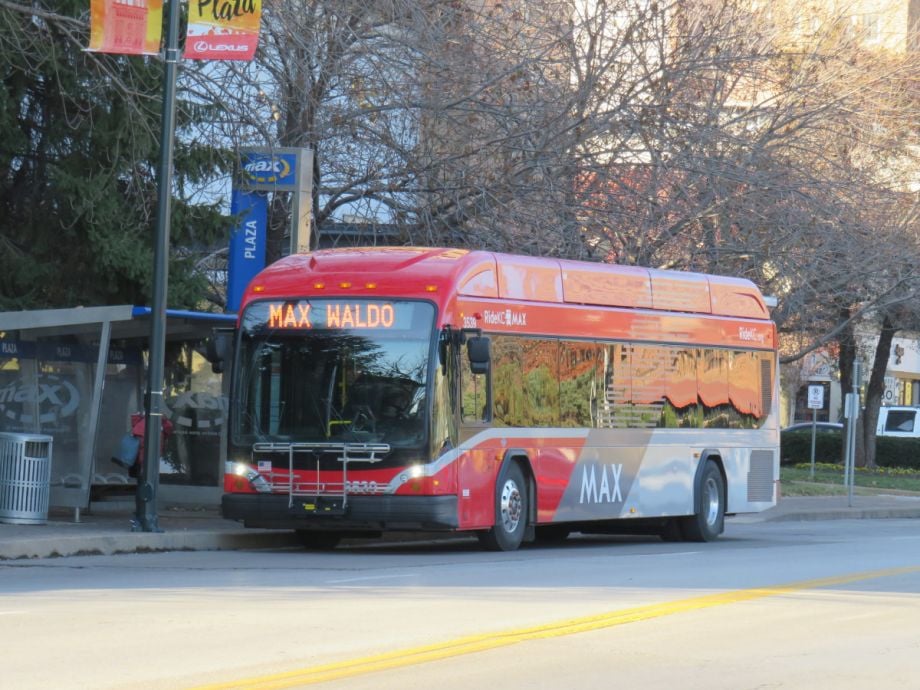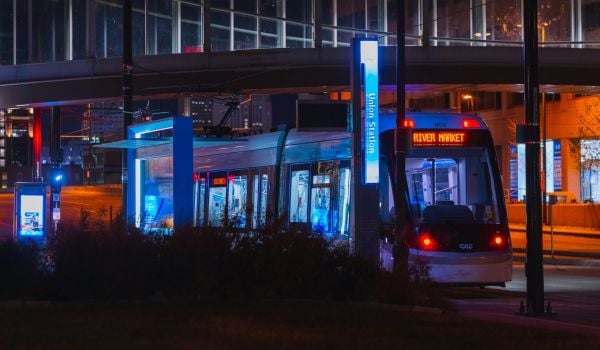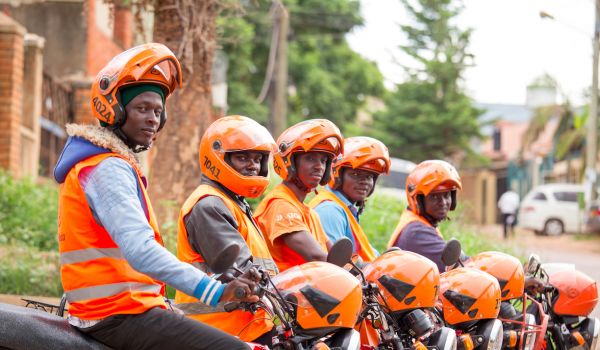Fare-free public transit is having a moment — with coverage from Freakonomics to Wired to Slate to right here at Next City. And while some experts are skeptical about the benefits, cities — and even states — are forging ahead with their own fare-free experiments, including Boston, Kansas City and Denver.
As cities around the country make taking the bus or train free, questions abound: Does dropping fares boost ridership? Does it increase equity for targeted populations? What are the impacts on the environment? Do the benefits outweigh the costs? Next City checked in with five cities across the U.S. that have launched fare-free public transit initiatives to see how it’s going.
Kansas City: Ridership satisfaction is up — but headways still matter.
Kansas City, home to tasty barbeque and the KCATA, has been offering free bus rides through ZeroFare KC since 2020 in what KCUR calls the “most expansive” program in the country. Now, the city says it plans to seek additional funding to extend the initiative past 2023.

(Photo via Sean Marshall / CC BY-NC 2.0)
After RideKC made buses free, straphangers reported better access to grocery stores (92%), healthcare (88%) and employment (82%). Notably, as we reported earlier this year, safety incidents also went down. “Over 75% of any incident we ever had on a vehicle was over a fare-box dispute,” said former KCATA CEO Robbie Makinen on Freakonomics. Ridership recovered more quickly in Kansas City compared to other metros during the Covid-19 pandemic — rebounding to 80% of 2019 numbers by October 2020.
However, the system also faces ongoing challenges, including an operator shortage and concerns from riders about long wait times and no-show buses. The city’s MAX rapid transit lines run north-south without corresponding east-west lines (Kansas City is historically racially segregated by Troost Avenue). Eliminating fares also costs the agency an estimated $8 million per year. Overall, while the program has boosted rider satisfaction and measures of equity, the city still has a long way to go in ending car dependence — only 3% of Kansas City residents commute by public transportation.
Chapel Hill: 20 years of free rides funded by two towns and one public university.
Chapel Hill Transit (CHT) out of Chapel Hill, North Carolina, has been offering free rides for all for over 20 years. The key to its success: a strong partnership between three entities. The University of Chapel Hill, the town of Chapel Hill and the town of Carrboro collectively fund the system. As the second largest transit agency in North Carolina, CHT serves an impressive number of riders, with about 7 million rides per year pre-pandemic.

(Photo by Ildar Sagdejev (Specious) / CC BY-SA 4.0)
Despite its long-running nature, CHT hasn’t gotten the same press as other fare-free programs. For one, Chapel Hill and Carrboro are uniquely shaped by UNC-Chapel Hill, the flagship campus in the UNC system with over 30,000 students. In fact, the university pays more into CHT than Chapel Hill and Carrboro combined. For 2021, Chapel Hill paid $5.5 million, Carrboro paid $1.9 million and UNC-Chapel Hill paid $8.5 million.
The big news? The North-South Bus Rapid Transit (BRT) project, slated to start service in 2028. The bus line will run 8.2 miles along one of Chapel Hill’s busiest corridors with pedestrian upgrades and affordable housing included as part of the plan. The BRT and brand new electric buses are all in service of the town’s climate goals.
Alexandria: More money, more (free) buses.
Meet the small city (pop <160K) that has it all: free fares and frequent service. Like many cities, Alexandria, Virginia, suspended fares on its DASH bus lines in the early days of the pandemic — fares were bringing in $4 million versus the $23 million cost of DASH in 2020. As of September 2021, DASH officially went fare-free. Currently, an influx of state funding will keep the program going until 2025 and ridership sits at an impressive 95% of pre-pandemic levels.

(Photo by MJW15 / CC BY-SA 4.0)
The city not only invested in free fares, it also invested in more frequent service as part of a redesigned bus network, with some buses coming every 10 minutes. Overall, Alexandria seems to bear out what transit experts have been saying all along: Fare-free programs work best in smaller systems and in conjunction with frequent and reliable service.
According to DASH General Manager Josh Baker, the shift to fare-free transit also represents an ideological shift — from seeing public transportation as a “pay-as-you-go service” to viewing it as public infrastructure, as he told The Washington Post. It’s one of the key arguments supporting free fares around the country.
Boston: Three free bus routes target equi-T.
Boston Mayor Michelle Wu has made headlines advocating for free public transit — “Free the T” — citing the effect of accessible and affordable transportation on economic mobility. It’s a compelling argument. People with lower incomes spend a higher percentage on transportation (up to 29% of household expenditure), and investing in fare-free programs could increase equity for underserved populations.

(Photo by Pi.1415926535 / CC BY-SA 3.0)
As of March 1, riders can ride for free on the 23, 28 and 29 bus routes in the MBTA system for two years. This expands on a previous pilot from August to December of last year that made Boston’s busy 28 bus free for six months. During the pilot, ridership topped 90% of pre-pandemic levels and boarding times dropped 20%. The new pilot will last until 2024 and is funded by $8 million in Covid relief funds.
It’s still early days in the expanded pilot. The 28 bus pilot boosted ridership by about 22%, with 5% coming from riders who would have otherwise driven. But only one-third of riders actually saved money due to the costs of taking other MBTA lines. With only three bus lines running fare-free, transferring to other buses or to the subway will still cost money.
Boston’s fare-free experiment has proven popular so far (faster boarding times have been a big hit), but it’s unclear where future funds will come from or if it will expand to include more routes. By targeting specific bus routes based on ridership demographics, Boston’s pilot can target equity without investing the dollars it would take to make the entire system fare-free.
Olympia: Saving money by going zero-fare.
In the Pacific Northwest, Olympia (pop. >52K) embarked on a five-year zero-fare experiment at the beginning of 2020 (the program may be extended three years due to the COVID-19 pandemic). According to the Intercity Transit website, fares only accounted for less than 2% of revenue. Given the projected cost of investing in a new farebox system required by the purchase of new buses, the agency decided to go fare-free instead, using funds from a 0.4% increase in sales tax to improve transit.

(Photo by Bluedisk at English Wikipedia / CC BY-SA 3.0)
Olympia’s transit agency seems to have an unusual amount of political will. Its motto for the initiative, “be bold and unafraid,” appears to have served the agency well.
By February 2020, ridership had increased by 20% or more than 60,000 additional riders. Like Alexandria, Olympia is a smaller city that seems well-suited for zero-fares — in 2021, it boasted a ridership of 2.2 million. The city also had a clear incentive to eliminate fares to avoid the high cost of collecting them and the support of constituents who voted to increase the sales tax to pay for better buses.
At the end of the demonstration term – early 2028 or three additional years from restoration of pre-pandemic service – the city will evaluate the program and decide whether to make it permanent.

Maylin Tu is Next City's Equitable Cities Reporting Fellow for Social Impact Design. A freelance reporter based in Los Angeles, she writes about transportation and public infrastructure (especially bus shelters and bathrooms), with bylines in the Guardian, KCET, Next City, LAist, LA Public Press and JoySauce. She graduated with a BA in English from William Jewell College in Missouri.
Follow Maylin .(JavaScript must be enabled to view this email address)
















